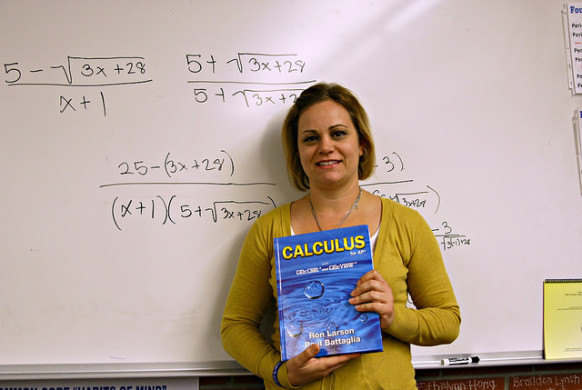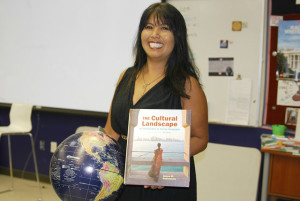
Shannon Atkins feels pleased with her new textbook that she prefers over last year’s. Photo by Elise Tran.By Anju Ito and Elise Tran, Staff Writers
This year, the Fountain Valley High School (FVHS) history department and some other classes including calculus and psychology have adopted new textbooks in hopes to make the contents more suitable for the students.
The process of adopting new textbooks occurs approximately every eight years in each department. This year, the history department had their turn-in, receiving their brand new textbooks with some other classes including calculus and psychology.
Each year, the district holds textbook adoption committees, where teachers from certain subjects get to discuss which textbook would be the best one for their upcoming students in the years ahead.
“We look at several different textbooks. I think we got about eight textbooks from different publishers, and having experienced teaching in calculus we just look at the textbooks and analyze how effective they’re going to be in our classrooms and possibly use them in our classrooms,” said Shannon Atkins, an algebra and calculus teacher at FVHS who was part of the textbook adoption committee last year.
After a few months of careful contemplation, the teachers all decide on their preferred textbooks, and gathering from all the schools in the Huntington Beach Union High School District, the teachers vote to pick the one final book that they would be using as a district.
However, this process has caused some conflicts in the past. Because of the fact that all the schools in the district have to have the exact same book for the same subjects, some schools are not able to get the resource that they had wanted.
“[After all the teachers discuss what textbooks they like,] we take a vote, and sometimes there’s contentions because other schools would like book B or book C, and then we have to kind of figure it out,”Julie Chaicharee, a world geography honors and United States government teacher, said, as she pointed out some problems of the system. “Then we come back and say ‘Sorry. We didn’t get the book you want.’ And then we have the whole department yelling, ‘No. This is not right,’ but we have to because we have one book, and that’s the way.”
This year, most of the textbooks had very few or minor changes in their contents, such as switching the order of some of the lessons and implementing new resources that are available for the students.
“[The new] book has a lot of resources. So for example, with the homework problems, there are QR codes in each of the different sections of problems and students can scan the QR code and watch a video explaining how to do a similar type of problem to their homework. So this book has a lot of online resources,” said Atkins.
Meanwhile, in one of the classes that Chaicharee teaches, world geography honors, the new textbook has caused her to change most of her class curriculum.
“[The old textbook] is regional. You’re going around the world and you’re learning different parts of the world. [The new textbook] goes right into the different topics so it’s a different way of teaching. For the lesson planning, it’s 100% different. So yeah, it’s a change for me,” Chaicharee said.
Overall, the teachers are mostly pleased with the new textbooks that they got.

“I much prefer [the new textbook]. I wasn’t a huge fan of our old textbook. The way that the old textbook presented some material was just different than what I was used to, having taught Calculus from a different textbook prior to that, and it just didn’t seem intuitive to me the way that they explained some things second semester and I like the way this book does it better. It’s just more like what I did when I first started teaching Calculus, so it’s more what I’m comfortable with,” said Atkins, looking forward to spending her time this year with her new textbook.





